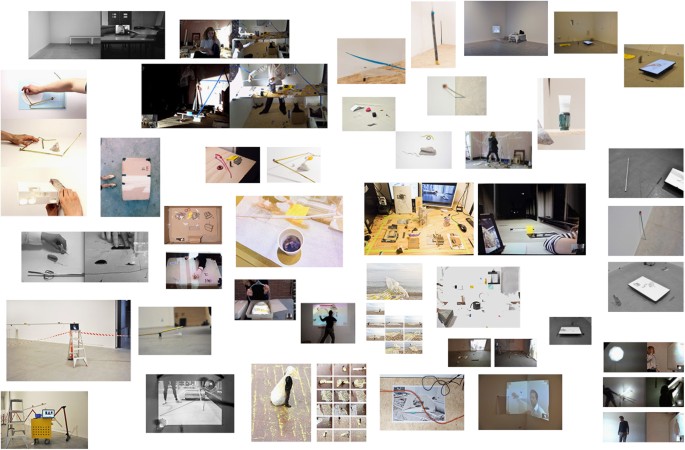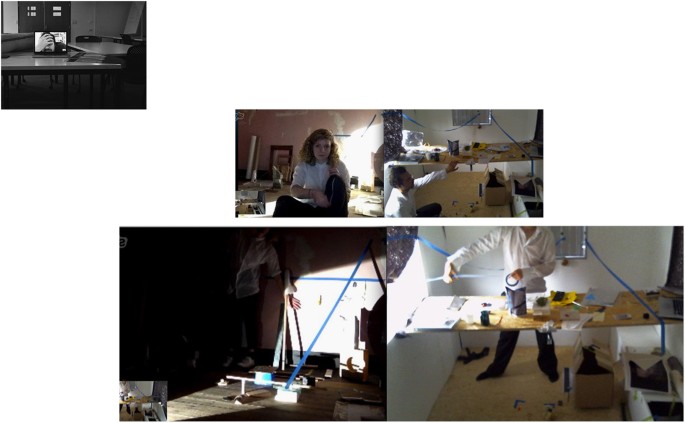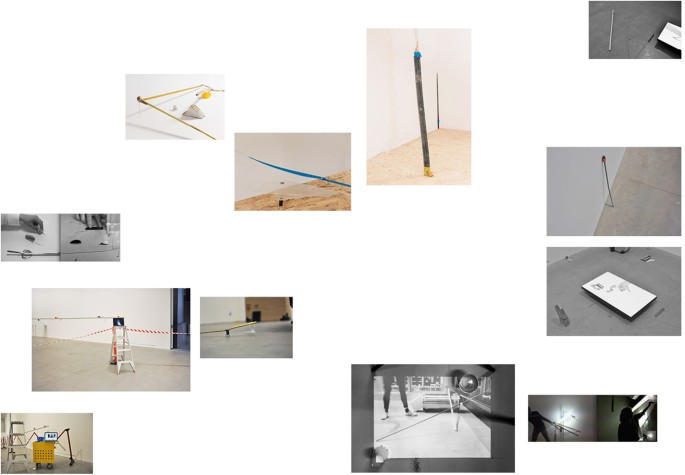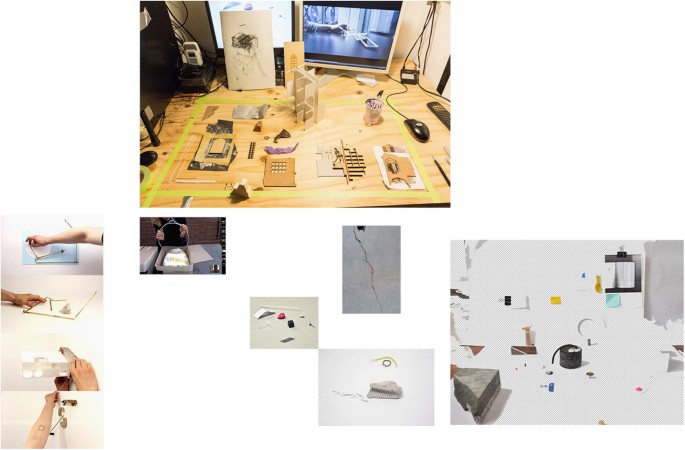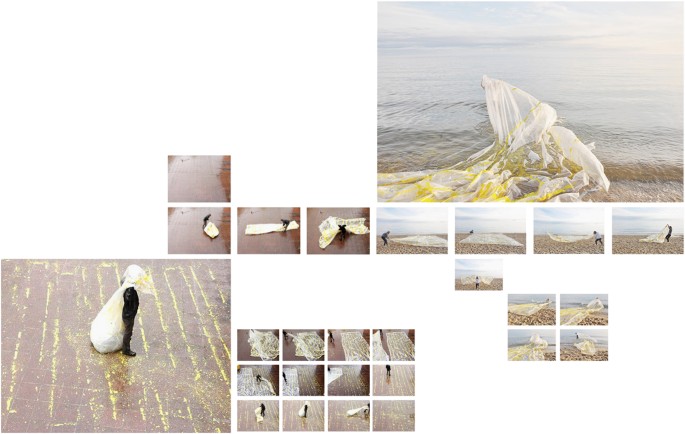Abstract
What could be the place of artistic research in current contemporary scholarship in the humanities? The following essay addresses this question while using as a case study a collaborative artistic project undertaken by two artists, Remco Roes (Belgium) and Alis Garlick (Australia). We argue that the recent integration of arts into academia requires a hybrid discourse, which has to be distinguished both from the artwork itself and from more conventional forms of academic research. This hybrid discourse explores the whole continuum of possible ways to address our existential relationship with the environment: ranging from aesthetic, multi-sensorial, associative, affective, spatial and visual modes of ‘knowledge’ to more discursive, analytical, contextualised ones. Here, we set out to defend the visual essay as a useful tool to explore the non-conceptual, yet meaningful bodily aspects of human culture, both in the still developing field of artistic research and in more established fields of research. It is a genre that enables us to articulate this knowledge, as a transformative process of meaning-making, supplementing other modes of inquiry in the humanities.
Introduction
In Being Alive: Essays on Movement, Knowledge and Description (2011), Tim Ingold defines anthropology as ‘a sustained and disciplined inquiry into the conditions and potentials of human life’ (Ingold, 2011, p. 9). For Ingold, artistic practice plays a crucial part in this inquiry. He considers art not merely as a potential object of historical, sociological or ethnographic research, but also as a valuable form of anthropological inquiry itself, providing supplementary methods to understand what it is ‘to be human’.
In a similar vein, Mark Johnson’s The meaning of the body: aesthetics of human understanding (2007) offers a revaluation of art ‘as an essential mode of human engagement with and understanding of the world’ (Johnson, 2007, p. 10). Johnson argues that art is a useful epistemological instrument because of its ability to intensify the ordinary experience of our environment. ImagesFootnote 1 are the expression of our on-going, complex relation with an inner and outer environment. In the process of making images of our environment, different bodily experiences, like affects, emotions, feelings and movements are mobilised in the creation of meaning. As Johnson argues, this happens in every process of meaning-making, which is always based on ‘deep-seated bodily sources of human meaning that go beyond the merely conceptual and propositional’ (Ibid., p. 11). The specificity of art simply resides in the fact that it actively engages with those non-conceptual, non-propositional forms of ‘making sense’ of our environment. Art is thus able to take into account (and to explore) many other different meaningful aspects of our human relationship with the environment and thus provide us with a supplementary form of knowledge. Hence Ingold’s remark in the introduction of Making: anthropology, archaeology, art and architecture (2013): ‘Could certain practices of art, for example, suggest new ways of doing anthropology? If there are similarities between the ways in which artists and anthropologists study the world, then could we not regard the artwork as a result of something like an anthropological study, rather than as an object of such study? […] could works of art not be regarded as forms of anthropology, albeit ‘written’ in non-verbal media?’ (Ingold, 2013, p. 8, italics in original).
And yet we would hesitate to unreservedly answer yes to these rhetorical questions. For instance, it is true that one can consider the works of Francis Bacon as an anthropological study of violence and fear, or the works of John Cage as a study in indeterminacy and chance. But while they can indeed be seen as explorations of the ‘conditions and potentials of human life’, the artworks themselves do not make this knowledge explicit. What is lacking here is the logos of anthropology, logos in the sense of discourse, a line of reasoning. Therefore, while we agree with Ingold and Johnson, the problem remains how to explicate and communicate the knowledge that is contained within works of art, how to make it discursive? How to articulate artistic practice as an alternative, yet valid form of scholarly research?
Here, we believe that a clear distinction between art and artistic research is necessary. The artistic imaginary is a reaction to the environment in which the artist finds himself: this reaction does not have to be conscious and deliberate. The artist has every right to shrug his shoulders when he is asked for the ‘meaning’ of his work, to provide a ‘discourse’. He can simply reply: ‘I don’t know’ or ‘I do not want to know’, as a refusal to engage with the step of articulating what his work might be exploring. Likewise, the beholder or the reader of a work of art does not need to learn from it to appreciate it. No doubt, he may have gained some understanding about ‘human existence’ after reading a novel or visiting an exhibition, but without the need to spell out this knowledge or to further explore it.
In contrast, artistic research as a specific, inquisitive mode of dealing with the environment requires an explicit articulation of what is at stake, the formulation of a specific problem that determines the focus of the research. ‘Problem’ is used here in the neutral, etymological sense of the word: something ‘thrown forward’, a ‘hindrance, obstacle’ (cf. probleima, Liddell-Scott’s Greek-English Lexicon). A body-in-an-environment finds something thrown before him or her, an issue that grabs the attention. A problem is something that urges us to explore a field of experiences, the ‘potentials of human life’ that are opened up by a work of art. It is often only retroactively, during a second, reflective phase of the artistic research, that a formulation of a problem becomes possible, by a selection of elements that strikes one as meaningful (again, in the sense Johnson defines meaningful, thus including bodily perceptions, movements, affects, feelings as meaningful elements of human understanding of reality). This process opens up, to borrow a term used by Aby Warburg, a ‘Denkraum’ (cf. Gombrich, 1986, p. 224): it creates a critical distance from the environment, including the environment of the artwork itself: this ‘space for thought’ allows one to consciously explore a specific problem. Consciously here does not equal cerebral: the problem is explored not only in its intellectual, but also in its sensual and emotional, affective aspects. It is projected along different lines in this virtual Denkraum, lines that cross and influence each other: an existential line turns into a line of form and composition; a conceptual line merges into a narrative line, a technical line echoes an autobiographical line. There is no strict hierarchy in the different ‘emanations’ of a problem. These are just different lines contained within the work that interact with each other, and the problem can ‘move’ from one line to another, develop and transform itself along these lines, comparable perhaps to the way a melody develops itself when it is transposed to a different musical scale, a different musical instrument, or even to a different musical genre. But, however, abstract or technical one formulates a problem, following Johnson we argue that a problem is always a translation of a basic existential problem, emerging from a specific environment. We fully agree with Johnson when he argues that ‘philosophy becomes relevant to human life only by reconnecting with, and grounding itself in, bodily dimensions of human meaning and value. Philosophy needs a visceral connection to lived experience’ (Johnson, 2007, p. 263). The same goes for artistic research. It too finds its relevance in the ‘visceral connection’ with a specific body, a specific situation.
Words are one way of disclosing this lived experience, but within the context of an artistic practice one can hardly ignore the potential for images to provide us with an equally valuable account. In fact, they may even prove most suited to establish the kind of space that comes close to this multi-threaded, embodied Denkraum. In order to illustrate this, we would like to present a case study, a short visual ‘essay’ (however, since the scope of four spreads offers only limited space, it is better to consider it as the image-equivalent of a short research note).
Case study: step by step reading of a visual essay
The images (1, 2, 3, 4, 5) form a short visual essay based on a collaborative artistic project 'Exercises of the man (v)' that Remco Roes and Alis Garlick realised for the Situation Symposium at Royal Melbourne Institute of Technology in Melbourne in 2014. One of the conceptual premises of the project was the communication of two physical ‘sites’ through digital media. Roes—located in Belgium—would communicate with Garlick—in Australia—about an installation that was to be realised at the physical location of the exhibition in Melbourne. Their attempts to communicate (about) the site were conducted via e-mail messages, Skype-chats and video conversations. The focus of these conversations increasingly distanced itself from the empty exhibition space of the Design Hub and instead came to include coincidental spaces (and objects) that happened to be close at hand during the 3-month working period leading up to the exhibition. The focus of the project thus shifted from attempting to communicate a particular space towards attempting to communicate the more general experience of being in(side) a space. The project led to the production of a series of small in-situ installations, a large series of video’s and images, a book with a selection of these images as well as texts from the conversations, and the final exhibition in which artefacts that were found during the collaborative process were exhibited. A step by step reading of the visual argument contained within images of this project illustrates how a visual essay can function as a tool for disclosing/articulating/communicating the kind of embodied thinking that occurs within an artistic practice or practice-based research.
Figure 1 shows (albeit in reduced form) a field of photographs and video stills that summarises the project without emphasising any particular aspect. Each of the Figs. 2–5 isolate different parts of this same field in an attempt to construct/disclose a form of visual argument (that was already contained within the work). In the final part of this essay we will provide an illustration of how such visual sequences can be possibly ‘read’.
Figure 1 is a remnant of the first step that was taken in the creation of the series of images: significant, meaningful elements in the work of art are brought together. At first, we quite simply start by looking at what is represented in the pictures, and how they are presented to us. This act of looking almost inevitably turns these images into a sequence, an argument. Conditioned by the dominant linearity of writing, including images (for instance in a comic book) one ‘reads’ the images from left to right, one goes from the first spread to the last. Just like one could say that a musical theme or a plot ‘develops’, the series of images seem to ‘develop’ the problem, gradually revealing its complexity. The dominance of this viewing code is not to be ignored, but is of course supplemented by the more ‘holistic’ nature of visual perception (cf. the notion of ‘Gestalt’ in the psychology of perception). So unlike a ‘classic’ argumentation, the discursive sequence is traversed by resonance, by non-linearity, by correspondences between elements both in a single image and between the images in their specific positioning within the essay. These correspondences reveal the synaesthetic nature of every process of meaning-making: ‘The meaning of something is its relations, actual and potential, to other qualities, things, events, and experiences. In pragmatist lingo, the meaning of something is a matter of how it connects to what has gone before and what it entails for present or future experiences and actions’ (Johnson, 2007, p. 265). The images operate in a similar way, by bringing together different actions, affects, feelings and perceptions into a complex constellation of meaningful elements that parallel each other and create a field of resonance. These connections occur between different elements that ‘disturb’ the logical linearity of the discourse, for instance by the repetition of a specific element (the blue/yellow opposition, or the repetition of a specific diagonal angle).
Confronted with these images, we are now able to delineate more precisely the problem they express. In a generic sense we could formulate it as follows: how to communicate with someone who does not share my existential space, but is nonetheless visually and acoustically present? What are the implications of the kind of technology that makes such communication possible, for the first time in human history? How does it influence our perception and experience of space, of materiality, of presence?
Artistic research into this problem explores the different ways of meaning-making that this new existential space offers, revealing the different conditions and possibilities of this new spatiality. But it has to be stressed that this exploration of the problem happens on different lines, ranging from the kinaesthetic perception to the emotional and affective response to these spaces and images. It would, thus, be wrong to reduce these experiences to a conceptual framework. In their actions, Roes and Garlick do not ‘make a statement’: they quite simply experiment with what their bodies can do in such a hybrid space, ‘wandering’ in this field of meaningful experiences, this Denkraum, that is ‘opened up’: which meaningful clusters of sensations, affects, feelings, spatial and kinaesthetic qualities emerge in such a specific existential space?
In what follows, we want to focus on some of these meaningful clusters. As such, these comments are not part of the visual essay itself. One could compare them to ‘reading remarks’, a short elaboration on what strikes one as relevant. These comments also do not try to ‘crack the code’ of the visual material, as if they were merely a visual and/or spatial rebus to be solved once and for all (‘x stands for y’). They rather attempt to engage in a dialogue with the images, a dialogue that of course does not claim to be definitive or exhaustive.
The constellation itself generates a sense of ‘lacking’: we see that there are two characters intensely collaborating and interacting with each other, while never sharing the same space. They are performing, or watching the other perform: drawing a line (imaginary or physically), pulling, wrapping, unpacking, watching, framing, balancing. The small arrangements, constructions or compositions that are made as a result of these activities are all very fragile, shaky and their purpose remains unclear. Interaction with the other occurs only virtually, based on the manipulation of small objects and fragments, located in different places. One of the few materials that eventually gets physically exported to the other side, is a kind of large plastic cover. Again, one should not ‘read’ the picture of Roes with this plastic wrapped around his head as an expression, a ‘symbol’ of individual isolation, of being wrapped up in something. It is simply the experience of a head that disappears (as a head appears and disappears on a computer screen when it gets disconnected), and the experience of a head that is covered up: does it feel like choking, or does it provide a sense of shelter, protection?
A different ‘line’ operates simultaneously in the same image: that of a man standing on a double grid: the grid of the wet street tiles and an alternative, oblique grid of colourful yellow elements, a grid which is clearly temporal, as only the grid of the tiles will remain. These images are contrasted with the (obviously staged) moment when the plastic arrives at ‘the other side’: the claustrophobia is now replaced with the openness of the horizon, the presence of an open seascape: it gives a synaesthetic sense of a fresh breeze that seems lacking in the other images.
In this case, the contrast between the different spaces is very clear, but in other images we also see an effort to unite these different spaces. The problem can now be reformulated, as it moves to another line: how to demarcate a shared space that is both actual and virtual (with a ribbon, the positioning of a computer screen?), how to communicate with each other, not only with words or body language, but also with small artefacts, ‘meaningless’ junk? What is the ‘common ground’ on which to walk, to exchange things—connecting, lining up with the other? And here, the layout of the images (into a spread) adds an extra dimension to the original work of art. The relation between the different bodies does now not only take place in different spaces, but also in different fields of representation: there is the space of the spread, the photographed space and in the photographs, the other space opened up by the computer screen, and the interaction between these levels. We see this in the Fig. 3 where Garlick’s legs are projected on the floor, framed by two plastic beakers: her black legging echoing with the shadows of a chair or a tripod. This visual ‘rhyme’ within the image reveals how a virtual presence interferes with what is present.
The problem, which can be expressed in this fundamental opposition between presence/absence, also resonates with other recurring oppositions that rhythmically structure these images. The images are filled with blue/yellow elements: blue lines of tape, a blue plexi form, yellow traces of paint, yellow objects that are used in the video’s, but the two tones are also conjured up by the white balance difference between daylight and artificial light. The blue/yellow opposition, in turn, connects with other meaningful oppositions, like—obviously—male/female, or the same oppositional set of clothes: black trousers/white shirt, grey scale images versus full colour, or the shadow and the bright sunlight, which finds itself in another opposition with the cold electric light of a computer screen (this of course also refers to the different time zones, another crucial aspect of digital communication: we do not only not share the same place, we also do not share the same time).
Yet the images also invite us to explore certain formal and compositional elements that keep recurring. The second image, for example, emphasises the importance placed in the project upon the connecting of lines, literally of lining up. Within this image the direction and angle of these lines is ‘explained’ by the presence of the two bodies, the makers with their roles of tape in hand. But upon re-reading the other spreads through this lens of ‘connecting lines’ we see that this compositional element starts to attain its own visual logic. Where the lines in image 2 are literally used as devices to connect two (visual) realities, they free themselves from this restricted context in the other images and show us the influence of circumstance and context in allowing for the successful establishing of such a connection.
In Fig. 3, for instance, we see a collection of lines that have been isolated from the direct context of live communication. The way two parts of a line are manually aligned (in the split-screens in image 2) mirrors the way the images find their position on the page. However, we also see how the visual grammar of these lines of tape is expanded upon: barrier tape that demarcates a working area meets the curve of a small copper fragment on the floor of an installation, a crack in the wall follows the slanted angle of an assembled object, existing marks on the floor—as well as lines in the architecture—come into play. The photographs widen the scale and angle at which the line operates: the line becomes a conceptual form that is no longer merely material tape but also an immaterial graphical element that explores its own argument.
Figure 4 provides us with a pivotal point in this respect: the cables of the mouse, computer and charger introduce a certain fluidity and uncontrolled motion. Similarly, the erratic markings on the paper show that an author is only ever partially in control. The cracked line in the floor is the first line that is created by a negative space, by an absence. This resonates with the black-stained edges of the laser-cut objects, laid out on the desktop. This fourth image thus seems to transform the manifestation of the line yet again; from a simple connecting device into an instrument that is able to cut out shapes, a path that delineates a cut, as opposed to establishing a connection. The circle held up in image 4 is a perfect circular cut. This resonates with the laser-cut objects we see just above it on the desk, but also with the virtual cuts made in the Photoshop image on the right. We can clearly see how a circular cut remains present on the characteristic grey-white chessboard that is virtual emptiness. It is evident that these elements have more than just an aesthetic function in a visual argumentation. They are an integral part of the meaning-making process. They ‘transpose’ on a different level, i.e., the formal and compositional level, the central problem of absence and presence: it is the graphic form of the ‘cut’, as well as the act of cutting itself, that turns one into the other.
Concluding remarks
As we have already argued, within the frame of this comment piece, the scope of the visual essay we present here is inevitably limited. It should be considered as a small exercise in a specific genre of thinking and communicating with images that requires further development. Nonetheless, we hope to have demonstrated the potentialities of the visual essay as a form of meaning-making that allows the articulation of a form of embodied knowledge that supplements other modes of inquiry in the humanities. In this particular case, it allows for the integration of other meaningful, embodied and existential aspects of digital communication, unlikely to be ‘detected’ as such by an (auto)ethnographic, psychological or sociological framework.
The visual essay is an invitation to other researchers in the arts to create their own kind of visual essays in order to address their own work of art or that of others: they can consider their artistic research as a valuable contribution to the exploration of human existence that lies at the core of the humanities. But perhaps it can also inspire scholars in more ‘classical’ domains to introduce artistic research methods to their toolbox, as a way of taking into account the non-conceptual, yet meaningful bodily aspects of human life and human artefacts, this ‘visceral connection to lived experience’, as Johnson puts it.
Obviously, a visual essay runs the risk of being ‘shot by both sides’: artists may scorn the loss of artistic autonomy and ‘exploitation’ of the work of art in the service of scholarship, while academic scholars may be wary of the lack of conceptual and methodological clarity inherent in these artistic forms of embodied, synaesthetic meaning. The visual essay is indeed a bastard genre, the unlawful love (or perhaps more honestly: love/hate) child of academia and the arts. But precisely this hybrid, impure nature of the visual essay allows it to explore unknown ‘conditions and potentials of human life’, precisely because it combines imagination and knowledge. And while this combination may sound like an oxymoron within a scientific, positivistic paradigm, it may in fact indicate the revival, in a new context, of a very ancient alliance. Or as Giorgio Agamben formulates it in Infancy and history: on the destruction of experience (2007 [1978]): ‘Nothing can convey the extent of the change that has taken place in the meaning of experience so much as the resulting reversal of the status of the imagination. For Antiquity, the imagination, which is now expunged from knowledge as ‘unreal’, was the supreme medium of knowledge. As the intermediary between the senses and the intellect, enabling, in phantasy, the union between the sensible form and the potential intellect, it occupies in ancient and medieval culture exactly the same role that our culture assigns to experience. Far from being something unreal, the mundus imaginabilis has its full reality between the mundus sensibilis and the mundus intellegibilis, and is, indeed, the condition of their communication—that is to say, of knowledge’ (Agamben, 2007, p. 27, italics in original).
And it is precisely this exploration of the mundus imaginabilis that should inspire us to understand artistic research as a valuable form of scholarship in the humanities.
Notes
We consider images as a broad category consisting of artefacts of the imagination, the creation of expressive ‘forms’. Images are thus not limited to visual images. For instance, the imagery used in a poem or novel, metaphors in philosophical treatises (‘image-thoughts’), actual sculptures or the imaginary space created by a performance or installation can also be considered as images, just like soundscapes, scenography, architecture.
References
Agamben G (2007) Infancy and history: on the destruction of experience [trans. L. Heron]. Verso, London/New York, NY
Garlick A, Roes R (2014) Exercises of the man (v): found dialogues whispered to drying paint. [installation]
Gombrich EH (1986) Aby Warburg: an intellectual biography. Phaidon, Oxford, [1970]
Ingold T (2011) Being alive: essays on movement, knowledge and description. Routledge, London/New York, NY
Ingold T (2013) Making: anthropology, archaeology, art and architecture. Routledge, London/New York, NY
Johnson M (2007) The meaning of the body: Aesthetics of human understanding. Chicago University Press, Chicago
Author information
Authors and Affiliations
Corresponding author
Additional information
Competing interests: The authors declare no competing financial interests.
Publisher’s note: Springer Nature remains neutral with regard to jurisdictional claims in published maps and institutional affiliations.
Rights and permissions
Open Access This article is licensed under a Creative Commons Attribution 4.0 International License, which permits use, sharing, adaptation, distribution and reproduction in any medium or format, as long as you give appropriate credit to the original author(s) and the source, provide a link to the Creative Commons license, and indicate if changes were made. The images or other third party material in this article are included in the article’s Creative Commons license, unless indicated otherwise in a credit line to the material. If material is not included in the article’s Creative Commons license and your intended use is not permitted by statutory regulation or exceeds the permitted use, you will need to obtain permission directly from the copyright holder. To view a copy of this license, visit http://creativecommons.org/licenses/by/4.0/.
About this article
Cite this article
Roes, R., Pint, K. The visual essay and the place of artistic research in the humanities. Palgrave Commun 3, 8 (2017). https://doi.org/10.1057/s41599-017-0004-5
Received:
Accepted:
Published:
DOI: https://doi.org/10.1057/s41599-017-0004-5

